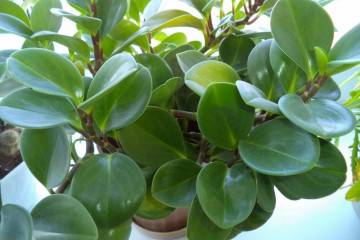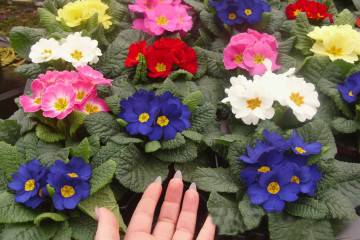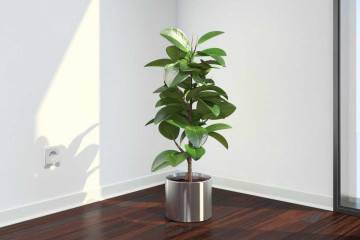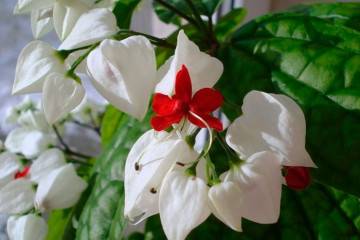Hypocyrta glabra: breeding methods and home care
Content:
Hypocyrta glabra refers to plants from the Gesneriaceae family. The main difference between the decorative culture is the presence of flowers, similar to sponges, which seem to be folded in anticipation of a kiss. The petals of the hypocyrt are colored in bright orange and yellow shades. Ornamental culture is grown at home as ampelous. The hypocyrt of this variety is very popular with flower growers. The shrub can be grown even by inexperienced flower lovers.
Hypocyrta: home care
If you follow all the recommendations of experienced florists, you can grow healthy bushes that delight with lush flowering and decorate the house.
Lighting and growing space
All varieties of nematanthus (the second name is hypocyrt) need abundant diffused light. Direct sunlight falling on the sheet plates can provoke burns. At the same time, the shrub growing in partial shade stops blooming. Therefore, experienced florists recommend placing containers with perennial crops near windows on the southwest side. Ampel varieties can be placed in hanging planters. This way, the plants will be able to get enough light and still avoid burns.
Drafts
When choosing a place to place containers of tropical flowers, it is necessary to avoid areas that are prone to drafts.
In the place where there is a pot with a glabra flower, do not turn on the air conditioner and fan. When the hypocyrt freezes, it loses its decorative features. Having frozen, the plant can shed its leaf plates.
Air humidity
The humidity level of the air plays an important role in the hypocyrthus glabra The plant, whose homeland is considered to be the rainforests of the Amazon, should not be kept near heating appliances. Dry air negatively affects the appearance of the flower.
During the period of active growth, an ornamental culture especially needs humid air. At this time, the humidity indicator should reach 70%. Every day, it is necessary to spray air near the glabra shrub. For this purpose, it is advisable to use a spray bottle. Containers with flowers are placed on pallets filled with a layer of wet expanded clay.
Temperature
When growing hypocyrta glabra, temperature drops should be avoided. In the summer, the temperature in the room should be between 22-25 degrees. In the cold season, the temperature may drop to 15-16 degrees. The hypocyrt flower is a thermophilic culture.
The soil
Going to buy ready-made soil, you should give preference to the soil mixture, which is produced for violets. If you wish, you can independently prepare the soil for planting flowers. The soil mixture will consist of the following components:
- leafy land;
- humus;
- river sand;
- peat.
Watering
The flowering period lasts from mid-spring to autumn. During this period of time, it is recommended to moisten the soil frequently and abundantly.
However, it is important to pay attention to the top layer of the earth.It should not be constantly wet, because against the background of this, the process of root rotting can begin.
Closer to October, the amount of soil moisture per week decreases and does not exceed 2 times. From November to the end of winter, the land is sprayed only when the topsoil dries out.
For irrigation, it is recommended to use settled soft water, the temperature of which is close to room temperature. Cold water used to moisten the soil can cause root rot.
Top dressing
In the warm season, the shrub needs top dressing. Every 2 weeks, starting in May, it is necessary to apply fertilizer to the soil. It is advisable to use for this purpose a concentrated mixture that manufacturers produce for flowering plants.
Before applying the concentrate to the soil, it must be combined and mixed with water intended for irrigation. Perfect for feeding cleaning:
- tangerine;
- orange;
- banana.
For the preparation of citrus dressing, you should thoroughly grind the peel of the fruit. The chopped peel is poured into a convenient container. Boiling water is poured over the citrus blank. The liquid is infused for 24-26 hours. After a specified period of time, the crusts are removed from the container, and the water is brought to a volume of 1000 ml by adding warm boiled water. The resulting infusion will be an excellent food for flowers. They can replace the planned watering of the nematanthus.
In the same way, you can prepare a banana dressing. The crushed banana peel is placed in a jar and filled with boiling water. After insisting throughout the day, the infusion should be filtered, and boiled water should be poured into the container. Plants can be watered with liquid every 2 weeks.
In addition, chopped banana peels can be mixed with the soil. The rotten peel compensates for the deficiency of trace elements in the soil substrate. Such fertilization will accelerate the growth of green mass.
Pruning
Before the dormant period begins, the shrub should be pruned. Pruning will allow new shoots to form correctly and allow for more lush flowering for the next season. Flower buds are laid on new shoots. It is advisable to shorten each branch during pruning by 1/3.
Dormant period
The dormant period for decorative culture begins at the end of October and ends in February. At this time, the hypocyrta glabra is gaining strength and is preparing for the next season. The pots of flowers should be kept in a room where the temperature reaches 16-18 degrees. The frequency of soil moistening is reduced to 4 times a month.
Transplant features
The hypocyrta glabra needs an annual transplant, which is recommended during the spring months. For this purpose, it is necessary to prepare in advance large containers filled with loose and light soil. To prepare the soil mixture you will need:
- peat land;
- sheet soil;
- river sand.
A third of the fern roots and a small amount of chopped bark and charcoal are added to the well-mixed components. If desired, you can purchase ready-made soil for violets in a specialized store.
A drainage layer is laid on the bottom surface of the planting pot to prevent liquid stagnation in the soil. Ideal for drainage:
- pebbles;
- gravel;
- crushed stone;
- brick chips;
- expanded clay;
- shards from pottery.
Reproduction of hypocyrtes
There are two ways to propagate a hypocyrt glabra:
- seed;
- by cuttings.
The seed propagation method is quite lengthy.However, flower growers often use this method. Below is a step-by-step process for planting seeds.
- Light soil, which is based on peat, is poured into pre-prepared long containers.
- Long grooves are made in the ground.
- The seeds are laid out at a short distance from each other in rows. Seed material is sprinkled with a small layer of sand.
- The soil is moistened with a spray bottle.
- The containers are covered from above with glass, which is removed only for airing until the first sprouts appear.
- In the process of growing seedlings, it is recommended to take the containers outside for 20-40 minutes. The time the seedlings stay outdoors increases gradually.
- As the seedlings grow, it should be thinned out, leaving the strongest and healthiest seedlings. 30 days after the planting work has been carried out, it is recommended to plant the flowers in separate containers. Taking care of your seedlings is pretty simple.
Propagation by cuttings is simple. From each adult nematanthus bush, apical cuttings with 6-8 internodes are cut, the length of which reaches 9-10 cm. Cutting can be carried out only from mature shoots. Cut branches from young shoots are characterized by weak rooting.
The bottom cuts on the cuttings should go under the knots. A pair of bottom sheet plates are removed. Cuttings can be rooted in:
- containers filled with water;
- in live sphagnum moss;
- container filled with loose peat substrate.
For successful rooting, it is necessary to take out containers with cuttings in a room where the temperature reaches 23-24 degrees. The rooting process lasts 14-21 days. As soon as the root system appears on the processes, it is necessary to transplant them into separate pots filled with a light, loose, moisture-permeable substrate. In addition, small amounts can be added to the soil:
- charcoal;
- pine bark;
- coconut fiber.
Observing the recommendations of experts, you can grow healthy bushes of naked hypocyrtes, which will delight with long and lush flowering. It is very important to avoid hypothermia of flowers, as a result of which a perennial can shed not only flowers, but also leaf plates. Caring for a hypocyrt is quite simple, but requires care.




















